IN 1988 LOIS WACHOLTZ and Christopher Jupp, owners of Christopher’s Fine Jewelry Design in Champaign, IL, teamed with gem dealer Bernie Goff to present the store’s first gemstone roundtable event. Since then other stores have had great success with the idea, too. Adam Graham, former director of marketing for the American Gem Trade Association, discussed gem roundtables during the 2012 American Gem Society Conclave in Miami, citing the experiences of llyn strong jewelry in Greenville, SC; T Lee Jewelers in Minneapolis; and Devon Jewelers in Wyckoff, NJ. “Stores are really kicking butt using these,” Graham says.
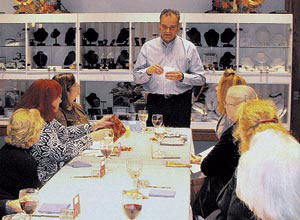
Gem cutter Roger Derry leads a gem roundtable at Devon Jewelers.
THE IDEA
Some stores hold gemstone roundtables as often as once a month. The inventory can be supplied by a dealer, so no large investment is necessary. There’s a great margin on loose stones. The events encourage collectors, provide an opportunity for store owners to establish their expertise and create a sense of urgency due to competition for available stones.
THE EXECUTION
Usually 12 to 18 guests participate. Christopher’s often hosts as many as 60 in four separate events over a weekend. “Twelve is a nice number; 15 is a perfect size table,” Wacholtz says. Smaller than that, and guests tend to be more quiet and the event lacks energy. “We serve wines and have the gem dealer at one end and Christopher, our designer, at the other end. The dealer sends papers around with the gems inside, and talks about the gemstones as they go around. Each person opens the gem paper and it moves all around the table.”
Advertisement
Choose a theme for the event (for example, gemstones from a certain part of the world), and pick a dealer or rep partner who will be able to bring 100 to 130 gemstones or pearls. When choosing a partner, consider the quality and selection of goods and the organizational abilities of the individual. If you’re interested in a series of events, plan a calendar with a variety of themes. Wacholtz says she tries to ensure that each dealer has an entirely different kind of collection: from faceted gems with relatively reasonable price points to one-of-a-kind pieces from some of the best known artisan carvers. Other dealers specialize in pearls and opals. Variety gives collectors a good reason to go to every show.
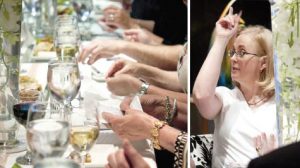
At llyn strong jewelry, guests open gem papers (left) and claim stones they want to buy (right).
“You must have good relationships with gem dealers who want to work with the retail customers,” Wacholtz says. “Many gem dealers are not the least bit interested in working with the retail client, but we’ve developed a group of gem dealers who are extremely good with retail customers and are happy to do these events. It allows them to get feedback on their work.”
Devon Jewelers owner Nancy Schuring, is currently hosting two events per year with gem cutter Roger Derry of Michigan, an AGTA Spectrum Award winner. Schuring has accompanied Derry to Tanzania, where she collected garnet, sapphire and tourmaline for an event. “It’s key to work with an experienced gem cutter, to find somebody that’s done this before,” Schuring says. “Then have fun with it. If people are even a little bit interested in gems, they make a great person for your table. We invite existing customers but try to mix it up with new people. We work on the guest list all year.” Schuring serves appetizers, wine and follows that up with chocolates or cupcakes and coffee. “We don’t want any drunks, but it is nice to break the ice a little bit by serving wine.”
Direct marketing should include a personal invitation and reminder calls. Explain what the event is about and provide information about the gem dealer.
“You are not telemarketing; you are offering them a wonderful chance they would not run into any other way,” Walcholtz says. “You are going to talk to voicemail, mostly, so have in your mind a gentle script and have them call you back.”
Advertisement
Requiring guests to RSVP creates a sense of urgency from the start. Say something like, “Seating is limited, so reserve your seat early.” Christopher’s requires guests to present their invitations at the door, for security purposes.
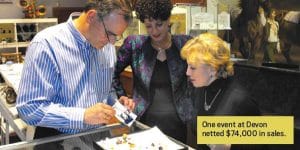
One event at Devon netted $74,000 in sales.
Clear space in the store, making sure there is room for a table and for staff to work behind clients.
If you don’t have room, consider planning an event off-site.
Make place cards, arrange for food and beverages and determine seating order.
Write down the description, origin, carat weight, parcel number and retail price of each stone. The gemstones are passed around the table and each guest has the opportunity to see and touch every gemstone, and along the way, fall in love. The guest can “dib” on stones (each identified by number) they particularly like and accumulate half a dozen gems in a tray to narrow down their selection. Keep a list of who had dibs on which stones first. When customers start competing for stones, it encourages an environment of competition and wanting to be a part of the action.
Advertisement
Once they have narrowed it down to one or two pieces, the guest discusses the gems with a sales associate.
When the dealer introduces the last five gems, the staff can begin to close sales, show some simple settings, and work with clients on custom possibilities for the gems they are considering.
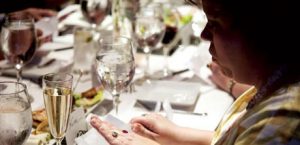
A guest at Ellyn strong jewelry visualise what an unmounted gem would look like on her finger.
THE RESULTS
Stores have reported remarkable success, both with immediate sales and future business, as guests return to have their stones set. “All these people are encouraging one another to buy these gemstones; there is so much support for them to make this purchase,” Graham says. When Devon Jewelers hosted 24 clients over two evenings, for example, they reported $74,000 in sales of gems and settings. A subsequent event in September 2012 brought in about $40,000.
At Christopher’s, 47 percent of custom business is attributed directly to monthly roundtable events. The sale of the loose stones alone at gemstone roundtables produce 30 percent of the store’s annual gross retail revenues while sale of the loose gems drives the custom business. Jupp does quick sketches on the spot to show guests what the possibilities are for the gemstones. “Remember, you may get one giant sale over a weekend, but if you don’t, it still really adds up with people all over the map — a lot of $500 to several thousand dollar purchases. “It’s a very relaxed atmosphere,” Wacholtz says. “You are among a table of strangers, but very quickly everyone seems to become comfortable.”
Do It Yourself
- Make the space for it. Even if you have a small store in the shape of an alley, with a row of cases on each side, there may be room for a long, narrow table down the middle.
- Don’t discount. There’s no need. This is a special event with unique gemstones in a competitive environment. The price is the price.
- Food should be simple, bitesize appetizers on small plates within easy reach of everyone.
- Complement the gemstones’ colors by decorating the table with flowers.
- Pair staff with customers; one staff per four guests allows for personal attention without being overwhelming.
- Keep energy and excitement high.
- Teach guests how to open and close the stone papers properly.
- Each gem is seen by each client. Encourage clients to try them on and see them in good light.
- Use white or black tablecloths, depending on the type of gemstones you are showing. Moonstones or pearls will look better on black.
- Create a collector card for each client with a list of gemstones on the back. Clients can aspire to collect at least one of each variety. One Devon client had 42 of 60 gemstones checked off.
- Make a lasting impression with thank-you gifts and the offer of a customer-referral reward.
- Follow up with each attendee, especially those who purchased a gemstone. A high percentage of buyers will want to set their gemstones. Offer a custom design credit as an incentive they return to you.
- Remember that you set the retail prices; the gem dealer does not, Wacholtz says. “You know your overhead; you know your market. There is very little price resistance because there is no easy way to compare and contrast. You can’t go to the jewelry store down the street and easily see 180 gemstones in one seating. And this is an event — you may not see that type of gemstone ever again, so there’s that urgency.”
- Don’t turn it into an educational event because that detracts from sales, Wacholtz says. “You want to sell the gemstones. The dealer has made a lot of effort, and come a long way. It’s in everybody’s interest to have the emphasis be on selling, but not in a pushy way.
- Don’t make the mistake of calling only your best customers. “You shouldn’t pre-judge,” Wacholtz says. “You have no idea who is going to buy. We go through our customer list in a random, constant way so that 30 to 35 percent are new to the environment and we are always building clientele. They might not buy the first time, it’s a little overwhelming, but they get hooked and they become collectors.”
BEST OF THE BEST IN BRIEF
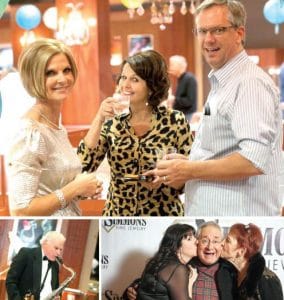
Simmons thanks its clients with an annual party.
Quick Ideas To Jump-Start Your Store
Simmons Fine Jewelry
IDEA: Simmons Fine Jewelry in Meridian, ID, hosts an annual non-selling event just before Thanksgiving, to thank customers and offer a preview of holiday merchandise. Typically, hundreds accept the invitation.
EXECUTION: In 2012, they hand-mailed 6,500 invitations to the Year of the Dragon-themed party. In addition to a $100 gift coin for a future purchase, guests also received John Hardy dragon lapel pins and were entered in a raffle for thousands of dollars of merchandise. Catering was Asian-inspired and included a self-serve ice cream machine. Guests were photographed as they made their red-carpet entrance.
REWARDS: The party has become a must-do tradition for customers, who return when it comes time to buy holiday gifts.
Goodman’s Jewelers
IDEA: Goodman’s Jewelers in downtown Madison, WI, owned by John Hayes, is four blocks from a university campus and two blocks from the state capitol, well situated for a steady flow of watch battery business. Every Monday — the busiest battery day — the proceeds from every watch battery sale are donated to Jewelers for Children.
EXECUTION: “We keep track of every battery sale, and at year’s end tally up the proceeds and send a check to Jewelers for Children,” says Hayes, who got the idea when he heard a child speak at a Wisconsin trade show about the benefits of the Make-AWish Foundation, a charity JFC supports.
REWARDS: Hayes has donated more than $12,000 in four years. “We do get people who tell us, ‘Because you do this, I want to come back and buy here,’” Hayes explains. But the primary reason Goodman’s does it is for the big difference those little batteries can make in children’s lives.
Browning &Amp; Sons Jewelers
IDEA: Browning & Sons Jewelers is a 25-year-old family owned store in downtown Hinsdale, IL, best known for its branded jewelry, says owner Rachel Browning. The store has carried A. Link for nearly 20 years, and so, when A. Link partnered with Forevermark, Browning rearranged her store in 2012 to accommodate the first Forevermark/A. Link zone in any retail jewelry store.
EXECUTION: A 9-foot wall incorporates a plasma screen that shows videos about both brands, while a Duratrans displays an ad from the Forevermark national campaign.
REWARDS: “It’s a simple, very clean design in black and white, so the contrast attracts people and fits in with everything else,” Browning says. “There isn’t a person who doesn’t walk in the door and comment on it.” Most important, Browning reports, the wall is driving the sale of diamond jewelry.
Howard’s Diamond Center
IDEA: Is it a jewelry store or a museum? Howard’s Diamond Center in Triadelphia, WV, is assembling a collection of estate jewelry, with items created in local stores that no longer exist, as well as vintage pieces that once belonged to local socialites.
EXECUTION: “At our annual estate jewelry sale, we unveiled our museum collection, which included gold pocket watches bearing the names of jewelers dating to the 1860s,” owner Seth Posin says. With the help of the local historical society, he has compiled a detailed history of each jewelry store. Old photos add extra dimension.
REWARDS: Posin has reinforced his deep roots while creating a multitude of storytelling opportunities.